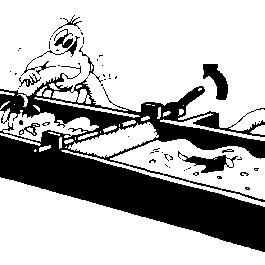 D I O D E
S
D I O D E
S
When you got a structure which is made out of a n-material and a p-material
then you call it a diode.

The strange thing about a diode is, that if you connect it across in a basic circuit then the electric current will just be able to flow in one direction.
In this two small pictures the electricity is represented by the water. As you can see : The water is only able to flow in one direction.
But how does it work that the electrons are not able to chose the direction of their movement when they flow through the diode ?
Well, for this explanation we really have to take a closer look at the boarder of the n- and p-material:
 As
we know by now the n-material has got free (negative) electrons and the
p-material has got free (positive) holes.
As
we know by now the n-material has got free (negative) electrons and the
p-material has got free (positive) holes.
So if the two materials come together, the electrons behave as they are used to:

The free electrons move towards the positive material and fit together with the positive holes.
This movement has got an important quality:
The n-material which has given some negative electrons becomes positive at its boarder.
And because the p-material has taken the electrons it becomes negative at its boarder.
 You
can say that if you connect both materials together then there will be
created a new voltage at the boarder.
You
can say that if you connect both materials together then there will be
created a new voltage at the boarder.
This zone is the reason why it is impossible for the electric current to flow through the material in both direction.
 Now
you connect for example the diode across the battery in a way that the
direction of the voltage is the same as the voltage at the boarder inside
the diode (here positive side connected to the n-material and the negative
side connected to the p-material).
Now
you connect for example the diode across the battery in a way that the
direction of the voltage is the same as the voltage at the boarder inside
the diode (here positive side connected to the n-material and the negative
side connected to the p-material).
The zone at the boarder becomes bigger in this case and the electric current is not able to flow.
 Let's
take a look at the other possibility and see what happens if we connect
th diode across the battery just the other way round.
Let's
take a look at the other possibility and see what happens if we connect
th diode across the battery just the other way round.
Now the electrons from the battery pushes the free electrons of the n-material. Then they move towards the positive holes and they are attracted by the positive side of the battery.
So now the electrons are able to move through the diode and the electric current flows.
Click here to return to the first page.
Copyright 1986: Pictures taken from the book "KOSMOS - Experimentierbuch für X 3000", Franckh'sche Verlagshandlung, W. Keller & Co., Stuttgart 1986